Research Highlights
Below is a list of some of the relevant Exercise is Medicine (EIM) literature, plus important position statements from the American Heart Association. Links are provided to the articles, but please feel free to contact a member of the team if you have trouble downloading a full copy of an article.
Our Impact
- Burnet B, Kelsch K, Chai T, Stoner L. (2019). Implementation of Exercise is Medicine On Campus at the University of North Carolina – Chapel Hill. In press
- Kelsch E, Burnet K, Moore JB, Stoner L. The Importance of ‘Time’ Prescription to Exercise Adherence: a Meta-Analysis. In press
Exercise is Medicine Research Publications
- Mealy et al (2019). Exercise is Medicine®: Knowledge and Awareness among Exercise Science and Medical School Students. Link
- McEachern et al (2019). Barriers and Facilitators to Implementing Exercise is Medicine Canada on Campus Groups. Link
- Boweb et al (2019). Exercise is Medicine as a Vital Sign: Challenges and Opportunities. Link
- Fowles et al (2018). Exercise is Medicine Canada physical activity counselling and exercise prescription training improves counselling, prescription, and referral practices among physicians across Canada. Link
- Dirks-Naylor et al (2016). The prevalence of exercise prescription-related course offerings in United States pharmacy school curricula: Exercise is Medicine. Link
- Cowan (2016). Exercise Is Medicine Initiative: Physical Activity as a Vital Sign and Prescription in Adult Rehabilitation Practice. Link
- Maier & Jette (2016). Promoting Nature-Based Activity for People With Mental Illness Through the US “Exercise Is Medicine” Initiative. Link
- Hill et al (2015). Training on Exercise is Medicine® Within an Integrative Medicine Curriculum. Link
- Cardinal et al (2015). If Exercise is Medicine, Where is Exercise in Medicine? Review of U.S. Medical Education Curricula for Physical Activity-Related Content. Link
- Coombes et al (2015). “Exercise is Medicine”: curbing the burden of chronic disease and physical inactivity. Link
- Sallis (2015). Exercise is medicine: a call to action for physicians to assess and prescribe exercise. Link
- Lobelo (2015). The Exercise is Medicine Global Health Initiative: a 2014 update. Link
- Joy (2013). Integrating exercise is medicine® into the care of pregnant women. Link
American Heart Association Position Statements
- Treat-Jacobson et al (2019). Optimal Exercise Programs for Patients With Peripheral Artery Disease: A Scientific Statement From the American Heart Association. Link
- Gilchrist et at (2019). Cardio-Oncology Rehabilitation to Manage Cardiovascular Outcomes in Cancer Patients and Survivors: A Scientific Statement From the American Heart Association. Link
- Forman et al (2017). Prioritizing Functional Capacity as a Principal End Point for Therapies Oriented to Older Adults With Cardiovascular Disease: A Scientific Statement for Healthcare Professionals From the American Heart Association. Link
- Ross et al (2016). Importance of Assessing Cardiorespiratory Fitness in Clinical Practice: A Case for Fitness as a Clinical Vital Sign: A Scientific Statement From the American Heart Association. Link
- Billinger et al (2014). Physical activity and exercise recommendations for stroke survivors: a statement for healthcare professionals from the American Heart Association/American Stroke Association. Link
- Marwick et al (2019). Exercise training for type 2 diabetes mellitus: impact on cardiovascular risk: a scientific statement from the American Heart Association. Link

